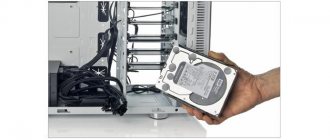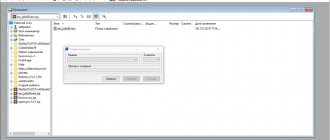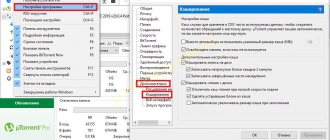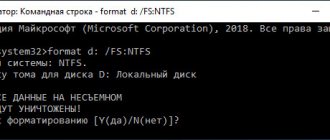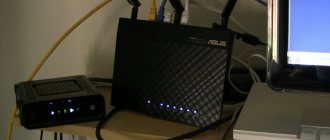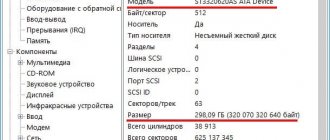11/26/2016 windows | for beginners | programs
When purchasing a computer or installing Windows or another OS, many users want to split the hard drive into two or, more precisely, into several partitions (for example, drive C into two drives). This procedure makes it possible to store system files and personal data separately, i.e. allows you to save your files in case of a sudden system crash and improve the performance of the OS by reducing fragmentation of the system partition.
Update 2020: new ways to split a disk (hard or SSD) into two or more have been added, a video has also been added on how to partition a disk in Windows without programs and in the AOMEI Partition Assistant program. Corrections have been made to the manual. Separate instructions: How to partition a disk in Windows 10.
See also: How to partition a hard drive during Windows 7 installation, Windows does not see the second hard drive.
There are several ways to partition a hard drive (see below). The instructions discuss and describe all these methods, indicating their advantages and disadvantages.
- In Windows 10, Windows 8.1 and 7 - without using additional programs, using standard tools.
- During OS installation (including how to do this when installing XP).
- Using free programs Minitool Partition Wizard, AOMEI Partition Assistant, and Acronis Disk Director.
How to partition a disk in Windows 10, 8.1 and Windows 7 without programs
You can partition a hard drive or SSD in all the latest versions of Windows on an already installed system. The only condition is that there be no less free disk space than you want to allocate for the second logical drive.
To do this, follow these steps (in this example, the system drive C will be partitioned):
- Press the Win+R keys on your keyboard and type diskmgmt.msc into the Run window (the Win key is the one with the Windows logo).
- After loading the Disk Management utility, right-click on the partition corresponding to your C drive (or another one that you want to partition) and select the “Shrink Volume” menu item.
- In the volume compression window, specify in the “Size of compressed space” field the size that you want to allocate for the new disk (logical partition on the disk). Click the Compress button.
- After this, a space that is “Unallocated” will appear to the right of your disk. Right-click on it and select “Create Simple Volume”.
- By default, a new simple volume is set to a size equal to all unallocated space. But you can specify less if you need to create multiple logical drives.
- In the next step, specify the drive letter of the drive you are creating.
- Set the file system for the new partition (it’s better to leave everything as it is) and click “Next”.
After these steps, your disk will be divided into two, and the newly created one will receive its own letter and will be formatted into the selected file system. You can close Windows Disk Management.
Note: You may later want to increase the size of your system partition. However, it will not be possible to do this in the same way due to some limitations of the considered system utility. The article How to enlarge drive C will help you.
How to properly delete the “System Reserved” partition
System Reserved is a hidden partition designed to save Windows 7 boot information. The partition is used to provide information necessary when the computer fails to boot and is not reflected in the Explorer logical drive tree. It is not recommended to delete a section; it can be made invisible to the user if it begins to appear in Explorer . This is done very simply:
- go to the “Disk Management” snap-in;
- right-click on the backup volume and in the drop-down context menu click on the line “Change drive letter or drive path...”;
In the drop-down menu, select “Change drive letter or drive path...”
- in the panel that opens, click on the “Add” button; in the next panel, indicate the letter that denotes the reserved disk;
In the panel, enter the drive letter to delete
- Double-click on the “Delete” button.
I do not recommend deleting this partition; it is better to leave everything as it was created when installing Windows 7. A size of 100 megabytes does not affect anything and is not worth breaking the system. It seems to me that Microsoft did not come up with it in vain.
Video: how to hide a “System Reserved” volume
How the “System Reserved” section is created
A backup volume always identifies itself as active, system, and primary. It can be used to launch one or two operating systems installed on a hard drive. If the partition was not created automatically during the system installation process, or was intentionally deleted, you can create it again by executing a certain command algorithm in the administrator console:
- opening the “Run” panel, in the “Open” field enter the line “Diskpart.exe”;
In the panel enter the command diskpart.exe
- enter the line list disk - display information about partitions;
- enter the line select disk - select a volume with working Windows 7;
- enter the line shrink desired=100 - shrink the volume by 100 megabytes;
- diskpart reduces the volume by 100 megabytes;
- enter the line creat partition primfry - create a volume;
- diskpart creates a partition;
- enter the line format fs=ntfs - format the volume in the NTFS file system;
- diskpart will format the volume;
- enter the line activ - the volume becomes active;
- enter the line assign letter J - assignment of an arbitrary letter;
- enter the line exit - exit the program;
- termination of work "Diskpart.exe";
- enter the line bcdboot C:\Windows - boot files are created in the “System Reserved” volume.
How to partition a disk using the command line
You can split a hard drive or SSD into several partitions not only in Disk Management, but also using the command line in Windows 10, 8 and Windows 7.
Be careful: the example shown below will work without problems only in cases where you have a single system partition (and possibly a couple of hidden ones) that needs to be divided into two sections - for the system and data. In some other situations (MBR disk and already have 4 partitions, when shrinking the disk, there is another disk "after" it) this may work unexpectedly if you are a novice user.
The following steps show how to split the C drive into two parts at the command prompt.
- Run Command Prompt as Administrator (how to do this). Then enter the following commands in order
- diskpart
- list volume (as a result of executing this command, pay attention to the volume number corresponding to drive C)
- select volume N (where N is the number from the previous paragraph)
- shrink desired=size (where size is the number, in megabytes, by which we will shrink drive C to split it into two drives).
- list disk (here pay attention to the number of the physical HDD or SSD disk on which partition C is located).
- select disk M (where M is the disk number from the previous paragraph).
- create partition primary
- format fs=ntfs quick
- assign letter=desired_drive_letter
- exit
Done, now you can close the command line: in Windows Explorer you will see the newly created disk, or rather, the disk partition with the letter you specified.
Preparation with separation using Windows tools
If you already have an OS installed and you do not intend to change it in the near foreseeable future, you can use the standard Windows tool. This operating system has a special service with which you can create and change virtual parts of the HDD. In order to split your media into two partitions, you need to do the following:
- Open the Start menu using the dedicated button on your keyboard or Quick Access Toolbar.
- Open Control Panel.
- Go to the section called "System and Security".
- Find the “Administration” category in the list provided and open the “Create and format hard disk partitions” utility.
- Here you need to select the local HDD that you want to split into 2 sections.
- Right-click on it and select the “Shrink Volume” option from the drop-down list.
- Wait while your personal computer calculates how much space can be taken from this volume.
- Specify the size of the space to be compressed (from which you will create a new virtual HDD) and click “Compress”.
How to partition a disk in Minitool Partition Wizard Free
Minitool Partition Wizard Free is an excellent free program that allows you to manage partitions on disks, including dividing one partition into two or more. One of the advantages of the program is that a bootable ISO image with it is available on the official website, which can be used to create a bootable flash drive (the developers recommend doing this using Rufus) or to burn a disc.
This makes it easy to perform disk partitioning in cases where this cannot be done on a running system.
After loading into Partition Wizard, you just need to right-click on the disk you want to split and select “Split”.
The next steps are simple: adjust the partition sizes, click OK, and then click the “Apply” button at the top left to apply your changes.
You can download the Minitool Partition Wizard Free bootable ISO image for free from the official website https://www.partitionwizard.com/partition-wizard-bootable-cd.html
How to partition a disk during installation of Windows 10, 8 and Windows 7
The advantages of this method include its simplicity and convenience. Partitioning will also take relatively little time, and the process itself is very clear. The main disadvantage is that the method can only be applied when installing or reinstalling the operating system, which in itself is not very convenient; in addition, there is no possibility of editing partitions and their sizes without formatting the HDD (for example, in the case when the space of the system partition has run out and the user wants add some space from another hard drive partition). Creating disk partitions when installing Windows 10 is described in more detail in the article Installing Windows 10 from a USB flash drive.
If these shortcomings are not critical, consider the process of disk partitioning during OS installation. These instructions are fully applicable when installing Windows 10, 8 and Windows 7.
- After launching the installation program, the bootloader will prompt you to select the partition on which the OS will be installed. It is in this menu that you can create, edit and delete hard drive partitions. If the hard drive has not been partitioned before, one partition will be offered. If it was split, you need to delete those partitions whose volume needs to be redistributed. In order to configure partitions on your hard drive, click the corresponding link at the bottom of their list - “Disk Settings”.
- To delete partitions on your hard drive, use the corresponding button (link)
Attention! When you delete disk partitions, all data located on them will be deleted.
- After that, create a system partition by clicking “Create”. In the window that appears, enter the partition size (in megabytes) and click “Apply”.
- The system will offer to allocate some space for the reserve area, confirm the request.
- Create the required number of partitions in the same way.
- Next, select the partition that will be used for Windows 10, 8 or Windows 7 and click Next. After this, continue installing the system as usual.
Creating a partition during Windows installation
I believe that this method is much more convenient and simpler than others, as it allows you to do everything at once during the installation process. But if you just want to split the disk into several, then this method is unlikely to suit you. The instructions are applicable for versions of Windows 7, 8 and 10. Their installation interface is almost the same.
As soon as you select the language and accept the license agreement, a window with section settings will appear. In it you need to create a new one by clicking on the corresponding button as shown below and assign its size.
If you do not have unallocated space and there are still partitions, then delete them using the appropriate button. They will be converted and a new partition can be made from them. Please note that all data on them will be permanently deleted.
Then select the created partition and click next to proceed to the simple installation process.
Partitioning a hard drive when installing Windows XP
During the development of Windows XP, no intuitive graphical interface was created. But although control occurs through the console, partitioning the hard drive when installing Windows XP is as easy as when installing any other operating system.
Step 1. Delete existing partitions.
You can repartition the disk while defining the system partition. You need to split the section into two. Unfortunately, Windows XP does not allow this operation without formatting the hard drive. Therefore, the sequence of actions is as follows:
- Select a section;
- Press “D” and confirm deleting the partition by pressing the “L” button. When deleting the system partition, you will also be asked to confirm this action using the Enter button;
- The section is deleted and you get an unallocated area.
Step 2. Create new partitions.
Now you need to create the necessary hard disk partitions from the unallocated area. This is done quite simply:
- Press the “C” button;
- In the window that appears, enter the required partition size (in megabytes) and press Enter;
- After this, a new partition will be created, and you will return to the system disk definition menu. Create the required number of partitions in the same way.
Step 3. Determine the file system format.
After the partitions are created, select the partition that should be system and press Enter. You will be prompted to select a file system format. FAT format is more outdated. With it you will not have problems with compatibility, for example, Windows 9.x, however, due to the fact that systems older than XP are rare today, this advantage does not play a special role. If you also consider that NTFS is faster and more reliable and allows you to work with files of any size (FAT - up to 4GB), the choice is obvious. Select the desired format and press Enter.
Then the installation will proceed in standard mode - after formatting the partition, the installation of the system will begin on it. You will only be required to enter user parameters at the end of the installation (computer name, date and time, time zone, etc.). As a rule, this is done in a convenient graphical mode, so it is not difficult.
Disk Management
If you need to partition the drive as soon as possible, then use standard OS tools. Windows 7 has a convenient Disk Management application that will allow you to partition your hard drive in just a few clicks.
This utility is available on Windows 8 and 10, so you can use this universal instruction.
So, let's move on to the division procedure:
- First, open Disk Management. The fastest way to do this is by searching in the Start menu for the request from the screenshot.
- You will see a list of all connected hard drives in the form of a table. Below is a visual diagram of the distribution of space on the device. Since you need to divide one space into two, right-click on the desired disk and select the “Shrink volume” action.
- In the new window, specify the size of the compressed space - the space allocated for the new hard drive partition. After specifying the size in megabytes, click on “Compress”.
- After this procedure, you will see that a new partition with the volume you specified has appeared in place of the previous disk. And next to it is an area labeled “Not distributed.” From this space you need to create part 2. To do this, click on “Create a simple volume” in the context menu.
- On the first screen, click Next.
- Specify the size of the second volume.
- Select a drive letter and click Next.
- Switch the setting to the bottom position to reveal more options. Specify the file system type as NTFS and enter the volume label (the name that appears in Explorer). Click on “Next”.
- To finish, click the “Done” button. Now this media is divided into two volumes. The first one retained the letter and name from the previous one, and the second one received a new label. You can close the application.
Space on new hard drives may not be allocated by default. Therefore, you don't have to shrink the volume, but simply create two new ones.
If your hard drive appears as dynamic in Disk Management, you need to convert it to basic. But before that, copy all data to a safe place.
Free AOMEI Partition Assistant
AOMEI Partition Assistant is one of the best free programs for changing the structure of partitions on a disk, transferring a system from HDD to SSD, and, among other things, you can use it to split a disk into two or more. At the same time, the program interface is in Russian, unlike another good similar product - MiniTool Partition Wizard.
Note: despite the fact that the program claims to support Windows 10, on my system it did not partition for some reason, but no failures occurred (I think it should be fixed by July 29, 2015). Works without problems in Windows 8.1 and Windows 7.
After launching AOMEI Partition Assistant, in the main program window you will see the connected hard drives and SSDs, as well as the partitions on them.
To partition a disk, right-click on it (in my case on C), and select the “Partition Partition” menu item.
At the next step, you will need to specify the size of the partition to be created - this can be done by entering a number, or by moving the separator between the two disks.
After you click OK, the program will display that the disk has already been partitioned. In fact, this is not the case yet - to apply all the changes made, you need to click the “Apply” button. You may then be warned that your computer will restart to complete the operation.
And after the reboot, you will be able to observe the result of disk separation in your Explorer.
Other programs for creating partitions on your hard drive
There is a huge amount of different software for partitioning a hard drive. These are both commercial products, for example, from Acronis or Paragon, and distributed under a free license - Partition Magic, MiniTool Partition Wizard. Let's look at dividing a hard drive using one of them - the Acronis Disk Director program.
- Download and install the program. When you first start, you will be asked to select an operating mode. Choose “Manual” - it is more customizable and works more flexibly than “Automatic”
- In the window that opens, select the partition that needs to be split, right-click on it and select “Split Volume”
- Set the size of the new partition. It will be deducted from the volume that is split. After setting the volume, click “OK”
- However, that's not all. We have only simulated the disk partitioning scheme; in order to translate the plan into reality, it is necessary to confirm the operation. To do this, click “Apply Pending Operations.” The creation of a new partition will begin.
- A message will appear asking you to restart your computer. Click "OK", after which the computer will restart and a new partition will be created.
